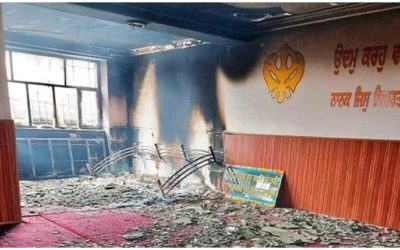MELVILLE, N.Y. — With each green chile prepared, the coughing grew louder. The smell, and kick, of Indian spices filled the kitchen air, as the volunteers prepared meals for the weekend.
Between sips of chai tea, the women plucked the stems off peppers, peeled cucumbers and diced tomatoes. Heaping bowls of mixed vegetables — peas and diced carrots — sat in wait.
Outside, the men were still building.
The decades-long effort to bring a Bochasanwasi Shri Akshar Purushottam Swaminarayan Sanstha temple to Long Island is finally over.
“We’re not building a church, we’re building a Hindu temple,” said Samir Bhatt, a volunteer who lives in Hicksville and works as a lawyer. “And while we are New York, and we’re still a very progressive, liberal state, it took some time.”
The golden temple, with domes and flags that stand out against a backdrop of trees, houses and office buildings, stands on Deshon Drive here. The 50,000-square-foot B.A.P.S. temple, or mandir, sits on five acres of land.

The 50,000-square-foot temple, or mandir, sits on five acres of land. After nearly three decades, “spiritual volunteerism” brought the project together, a volunteer at the temple said. Credit: Sasha Maslov for The New York Times
“Our spiritual leader, His Holiness Pramukh Swami Maharaj’s dream, was to build a temple for the Indian community in Suffolk and Nassau Counties,” said Dr. Vipul Patel, an oncologist who is also a volunteer.
The spiritual leader first talked of a temple in 1988, Dr. Patel said. He died in India in August at 94. In the early 2000s, after B.A.P.S. secured the land in Melville, Pramukh Swami Maharaj blessed the land and sanctified the idols.
After nearly three decades, “spiritual volunteerism” has brought the project together, Dr. Patel said. Contractors built the bare-bones structure, but volunteers completed most of the work.
B.A.P.S. is a worldwide socio-spiritual organization “for the nurturing and the growth of the individual,” he said. The temple includes an assembly hall, a dining area, an indoor basketball court and classrooms. Youths can take SAT preparation classes or study subjects like music, dance and languages.
The building’s exterior is made of a material called FRP, or fiber-reinforced polymer — “a fancy word for, like, hard plastic,” Mr. Bhatt said — and was shipped in puzzlelike pieces from India then assembled by volunteers.
“The style, the architecture, is authentic and consistent with the ancient Indian traditions,” Mr. Bhatt said.

Devotees performing a ritual called yagna. Credit: Sasha Maslov for The New York Times
A book stall inside offers Hindu scriptures at various reading levels, as well as dry meals, like “the Indian Chex Mix,” he said.
He and his wife will now bring their young sons to the temple here instead of going to Flushing, Queens — a 10-minute ride each way instead of a 30-minute ride.
“I think, my parents, it was different, so they’d be willing to drive two hours for something that they deem important,” he said. “In my generation, I think it’s harder. Every minute is accounted for.”
Proximity aside, going to the Melville temple is “almost like an experience, as well,” Mr. Bhatt said. His children were in awe of the temple when they saw it, the way he had only seen them react to new toys, he said.
“In an ideal world, worshiping is worshiping, right? You could sit in your house, and you can do that,” Mr. Bhatt said. “But to feel the serenity, the sanctity, in a traditional, authentic place of worship has a different feel.”
B.A.P.S. worked for years to overcome the logistic and financial obstacles, he said.
When Bhumi Joshi was a little girl, she learned about her Hindu heritage at the B.A.P.S. mandir in Flushing, Queens. Now 38, Ms. Joshi, a New Hyde Park resident, said she was looking forward to the increased flexibility the new temple would offer her family.

The food served over the weekend was prepared and served entirely by volunteers, in keeping with the emphasis on the value of community service. Credit: Sasha Maslov for The New York Times
“In New York, which is metropolitan, you get Indian food at every corner,” she said, but to learn how to cook and eat ethnic food is different, and an important part of understanding the culture.
To have a B.A.P.S. temple on Long Island in addition to the one in Queens “means everything,” Ms. Joshi said.
“This is where my children will learn who they are, where they come from,” she said.
On Sunday, Steve Bellone, the Suffolk County executive, addressed the hundreds of people who had gathered, thanking them for building the temple.
“Long Island, Suffolk County, this nation, this world, is enriched, is made better, by all of the people inside this room here today, and what you believe, and what you preach, and what you practice every day in your life,” he said.
Sometimes, Mr. Bellone said, he looks at the strife and war in the world and wonders what the future will look like.
“And then I come here,” he said, “and I look out into this room. And what I see is literally an army of people who are good, and fighting for good, and what is best about humanity in our world today.”




0 Comments